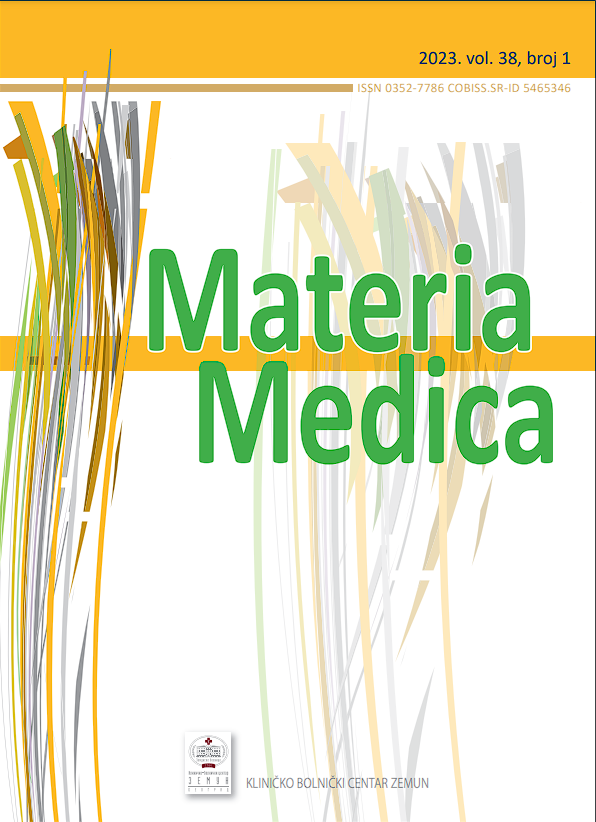Current issue

Volume 39, Issue 1, 2025
Online ISSN: 3042-3511
ISSN: 3042-3503
Volume 39 , Issue 1, (2025)
Published: 31.03.2025.
Open Access
Welcome to Issue 39, No. 1 – the first of our two annual publications for this year. Inside, you'll find a curated selection of articles. Start your year with the essential knowledge and perspectives offered in this timely edition
All issues
Contents
01.01.2019.
Review Article
CHC Zemun Teaching Center of Surgery and Anesthesiology, Faculty of Medicine, University of Belgrade
Dragoš Stojanovic, Dejan Stevanović, Nebojša Mitrović
01.01.2019.
Original Article
Kliničko bolnički centar Zemun-Beograd 21 vek (2010-2019)
Dragoš Stojanović, Sanja Milenković
01.09.2019.
Actual
ERAS Protocol in Laparoscopic Colon Surgery
Colorectal cancer, as one of the leading oncological causes of disease worldwide, is a major challenge in terms of treatment and patient access. Technological advances have made it possible to apply a minimally invasive laparoscopic surgical technique that has proven superior to open surgery. In order to optimize treatment, reduce mortality and morbidity, a perioperative strategy has been developed summarized in the principles of ERAS protocol (Enhanced Recovery After Surgery). The basic postulates of the ERAS protocol include prehabilitation, comorbidity control, prevention of postoperative nausea and vomiting, minimally invasive surgical method, multimodal analgesia, achieving euvolemia, prevention of hypothermia and early mobilization of the patient. The principles of the ERAS protocol are based on evidence to support safety, applicability and effectiveness, however, there are not yet enough studies to examine the long-term benefits of their implementation. The implementation of the ERAS protocol at KBC “Dr Dragisa Misovic -Dedinje” is not complete, but there is significant compliance with the guidelines of the 2018 ERAS Association, which has reduced inpatient stays and the number of postoperative complications. Although there is ample evidence to support the safety and effectiveness of this treatment approach, a multimodal strategy poses a major challenge to traditional surgical doctrine, making its implementation slow and incomplete in practice.
Irina Nenadic, Katarina Oketic, Ana Janicevic, Marko Djuric, Marina Bobos, Miljan Milanovic, Dragan Radovanovic, Dejan Stojakov, Predrag Stevanovic
01.05.2019.
Original Article
Therapeutic Plasma Exchange in the Treatment of Retrobulbar Neuritis Attacks in Patients with Multiple Sclerosis
The aim of this case report was to review the therapeutic effect of therapeutic plasma exchange in the treatment of retrobulbar neuritis in relation to its side effects, in the absence of the desired therapeutic response to previously applied immunomodulatory therapy, as a justification of therapeutic plasma exchange in the treatment of patients suffering from central nervous system demyelinating diseases. Optic neuritis is an inflammatory optic nerve lesion that may lead to partial or complete loss of vision. Therapeutic plasma exchange was performed on the SPECTRA OPTIA apheresis apparatus, according to a predefined disease diagnosis (RN), which according to the 2016 AFSA criteria belongs to the III category of disease in which apheresis is accepted as the second line of treatment. Three procedures were analyzed and an average of 5050ml of blood was processed. In conclusion, this therapeutic method is absolutely justified, with the appropriate prior preparation of the patient.
Dragoslava Jovanović, Sonja Krmek
01.01.2019.
Reprint: Materia Medica
Clinical Hospital Center Zemun through the centuries - 18th century
Zemun hospital, the present-day Clinical Hospital Zemun-Belgrade, was founded in 1784, is the oldest hospital in the Serbia. For over two centuries, it blazed the trial and still pioneers in the application of numerous advanced medical achievements and knowledge in this region.
Sanja Milenkovic, Jasmina Milanovic
01.01.2019.
Review Article
CHC Zemun Teaching Center of Otorhinolaryngology and Maxillofacial Surgery, Faculty of Medicine, University of Belgrade
Milan B. Jovanovic, Ognjen Cukic, Svetlana Valjarevic, Sanja Nikolic
01.01.2019.
Review Article
CHC Zemun Teaching Center of Internal Medicine, Faculty of Medicine, University of Belgrade
Aleksandar N. Neskovic
01.01.2019.
Reprint: Materia Medica
Clinical Hospital Center Zemun through the centuries - 21th century (2000-2010)
Sanja Milenkovic
01.01.2019.
Reprint: Materia Medica
Clinical Hospital Center Zemun through the centuries - 20th century
The 20th century was the most eventful period in the history of Zemun Hospital and it brought many changes. Working through out both world wars, the hospital staff aided those who were wounded or ill, both soldiers and civilians. Throughout this period, the hospital worked in three different countries, under various administrations and owners.
Sanja Milenkovic, Jasmina Milanovic
01.01.2019.
Reprint: Materia Medica
Clinical Hospital Center Zemun through the centuries - 19th century
The development of Zemun Hospital in the 19th century was followed by better work conditions and an increasing number of patients. The arrival of doctor Vojislav Subotić to the hospital and his work were key moments in the general improvement of the hospital. Since 1887, the hospital was administered by a society known as „Sisters of Charity of Saint Vincent De Paul“. By the end of 1891, they had constructed a new hospital building.
Jasmina Milanovic, Sanja Milenkovic









